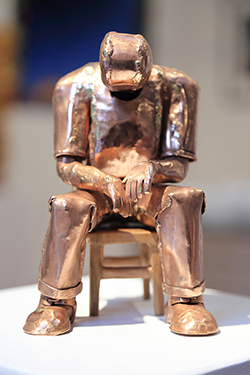While the Salt Spring National Art Prize aims to bring the best contemporary art from across the nation to a small island outpost in the Pacific, the prize founders have always had the joint goal of bringing more exposure to the top-notch artists living and working in this place.
The Parallel Art Show at ArtSpring is therefore an important companion event to the SSNAP Finalists Exhibition, and one that has been evolving to include more stringent curatorial practices. This year the 52 participating artists were selected by a three-member jury. Once again entry was restricted to artists from the Southern Gulf Islands who submitted to SSNAP, with the Parallel Art Show jurists reviewing those same entries. The field of choice was a large one this time, with 150-plus artists submitting over 250 works. As SSNAP founding director Ron Crawford said at the opening reception last Sunday, this was by no means an easy show to get into.
In terms of technique, creativity and sophistication of expression, there is no doubt island artists stack up well against the national scene. At the same time, the islands’ unique demographics, geography and culture inspire some particular concerns and ways of looking at the world that both fit into the larger Canadian context and are tied to this specific place.
With our close connection to nature and Green-party supporting majority, it’s not surprising that climate change and the destruction of ecosystems are common issues arising in the show. Gillian McConnell treats the topic in Carbon Cycle, an acrylic and multimedia abstract work where black and grey tones underscore the harmful human disruption of organic processes.
Karen Reiss’ sculpture A Pipeline Runs Through It depicts a fractured world in reassembled shards of broken ceramic tile, but with the hope that it’s possible to remake what’s not working.
Jane Kidd’s stunning woven tapestry Forlorn deals with the unlearned lesson of the passenger pigeon and the human-caused extinction of species. Her sad pigeon lies breast-up against a brilliant blue sky darkened by a huge flock of birds about to disappear; decorative borders add a glibly cheerful contrast to the looming tragedy.
Amy Melious also provides a warning with Next Step. The delicately hand-tinted photo composite frames a tightrope act over a scene of clear-cut devastation. In the distance of this wasteland are tiny figures standing on a giant stump. The safety railing suggests this is an image of a tourist site where people marvel over what used to be.
Nature inspires other lines of inquiry as well, and serves as the base for deepening explorations into process and technique. Tree roots provide the metaphor for human introspection during the pandemic in Terri Bibby’s lovely textile sculpture Roots: Exposed. The roots radiate from the base in a star pattern in hand-dyed cotton, wool and raffia.
Liljana Mead Martin has a beautifully rendered conceptual piece called The Listener. A charred black length of tree trunk hosts delicate translucent turquoise fungi, shapes that were in fact cast from the artist’s ear. The piece draws on speculative fiction and magic realism to consider “our current environmental conditions and the potential for learned exchanges with other forms of life.” At the same time as diving into these deep concepts, it is simply beautiful to look at.
Also beautiful in composition and execution is Rosie Schinners’ Land Sky Sea piece. Schinners has a distinct style of paper collage, giving well-chosen images more impact through sparing placement against a clean white background, and the application of intense colour saturation. Here, a series of three walking figures in an Eadweard Muybridge 1887 photo series provide the dynamic supports for a brilliant arc of animals and flowers, a joyful parade where the ideal of harmony is manifest.
The impact of the times we live in informs Pender artist Mimi Fujino’s luminous lino print Reflecting Back, a scene dominated by a window looking directly onto the slopes of a golden mountainside.
Judith Walker (also from Pender) reflects fears of a dystopian reality in her expressive abstract painting A Cautionary Tale, which features a jarring tower of marks in vermillion over soft grey. Both Kazmear Johnston and John Hoyle express fears and grief of COVID isolation in moving sculptural form: Johnston in a haunting ceramic depiction of a not-quite human face, and Hoyle with the heartbreaking slumped figure in copper pipe called Alone Again.
Younger artists in the show stretching their creative muscles with deep explorations of technique include Mayne Island’s April Winter, whose self-portrait photo tableau is a study in colour and clothing as false markers of identity. In this case, seemingly cheerful bright yellow clashes with the artist’s facial expression and the rainwear theme.
Seb Evans tackles the theme of artisans in their workplaces in The Shoemaker in His Shop, based on a historic photo of Victoria. Evans’ incredibly detailed woodcut print captures the frenzy of the cluttered room with countless carved lines and the balanced use of positive and negative space.
On the other end of the spectrum according to age and experience, Susan Benson puts all of hers into a masterful installation that combines history, contemporary politics and the deeply personal. Her meticulous model of a bombed-out home in London speaks to her family’s terrifying time in the Second World War. Portraits of her family members in window panes surround the model along with scenes of bombers and Nazi symbols. As someone who can attest that pain and terror have multigenerational impacts, Benson was motivated by her absolute horror that anyone today has taken up Nazi symbols as emblems.
The Parallel Art Show runs daily from 10 a.m. to 4 p.m. to Oct. 17. The works are eligible for Juror’s Choice and Viewer’s Choice awards, which will be announced along with the SSNAP prize winners on Oct. 23.





